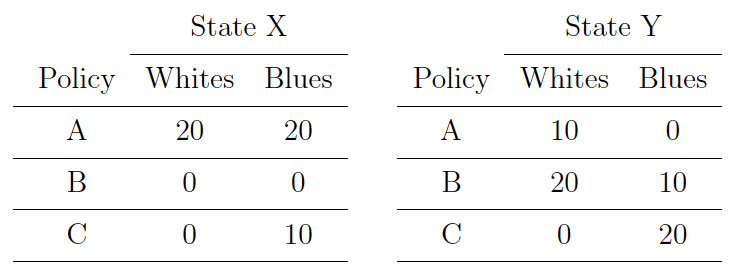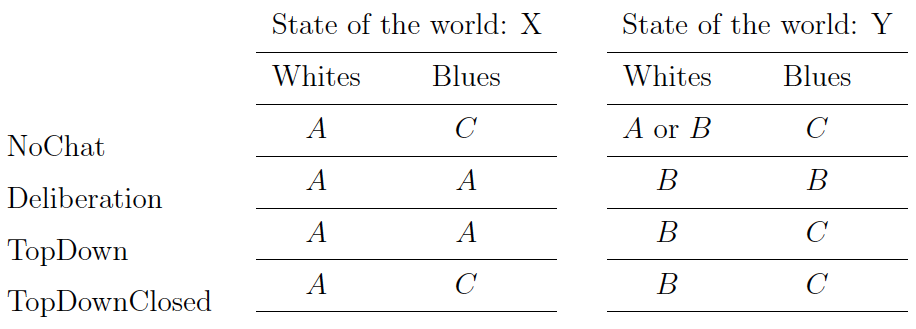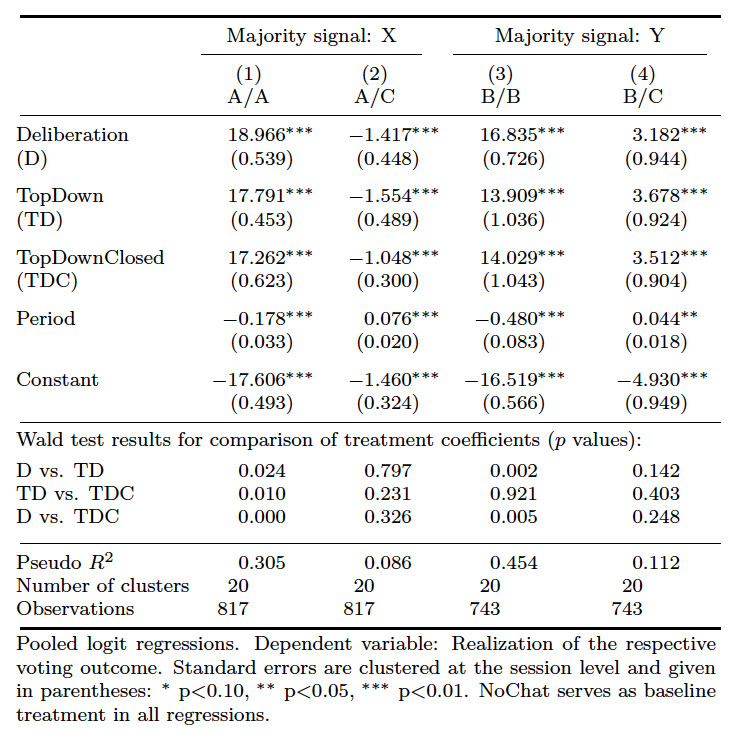Inequality in democracies not only involves differences in economic opportunities, but also differences in access to information about the workings of society, as well as different levels of social influence through different access to communication channels. A sound analysis of how these inequalities interact and potentially even reinforce each other is essential for a better understanding of some of the current socio-political tensions in modern societies.
In their BSE Working Paper No. 1022, “Deliberative Structures and their Impact on Voting Behavior under Social Conflict”, Jordi Brandts, Leonie Gerhards and Lydia Mechtenberg present the results from a laboratory experiment based on a voting game that sheds light on these interactions. The authors use different deliberative structures in the experiments which lead to conflicting choices among different groups. In particular, they try to demonstrate that in cases where informed and uninformed parts of the society have different interests, efficient outcomes may be hard to reach.
Environment
The authors study an environment which represents a society split into two distinct groups that differ along various dimensions. The state of the world is uncertain and while the members of one of the groups have some information about the state of the world, the members of the other group are uninformed. In both states of the world, the same set of policies can be implemented, which lead to different distributions of material payoffs between the groups. In one state of the world, the two groups have conflicting material interests, whereas in the other state their material interests are aligned. The collective choice of policy is determined by a vote in which all individuals from both groups can participate. Before the vote takes place the individuals of both groups can communicate with each other under protocols or deliberative structures that differ in the hierarchy between the informed and the uninformed. Communication is free-form.
Deliberative structure and information asymmetry
In the lab experiments there are two groups which have different payoffs and receive different information. Authors use different colors to refer to the two groups, white for the informed and blue for the uninformed. Given these differences, they study how group identity is affected by the different deliberative structures. In particular, four deliberative structures are considered in four distinct experimental treatments. In the baseline treatment, NoChat, there is no communication between participants. The other three deliberative structures model different degrees of openness of a society. In the first, called Deliberation, the two groups are on equal footing and communication is unrestricted. In the deliberative structure called TopDown, only the informed group has access to public communication channels while the uninformed group can only see the messages written by the informed group but cannot write. Finally in TopDownClosed, initially all members of the informed group can freely communicate with each other without the uninformed being able to read these messages and then, in a second stage, communication takes place like TopDown.
Experimental design
The experiment is based on the game shown in Table 1 below. Six players form a voting group, consisting of three white players and three blue players. The implemented policy determines state dependent payoffs that may differ by color. At the beginning of the game, nature draws the state of the world, which is either X or Y with equal probability. Then, nature randomly draws informative private signals on the state of the world for each white player. Then players vote on a policy from the set of three alternatives (A, B, and C).

In the good state X, whites and blues would agree on the most preferred policy: Both would like to implement policy A. However, in the bad state Y, the whites would prefer B to be chosen, the blues would prefer C instead which creates a state-dependent conflict. The efficient policy choice is A in state X and B in state Y and is hence both state-dependent and in line with the preferences of the whites.
Hypothesis: Greater Information sharing leads to a more efficient outcome
The central hypothesis of the paper derived from the theoretical analysis is that Deliberation where information sharing is most transparent, the voting groups will more often make an efficient policy choice. As the communication asymmetry increase from TopDown to TopDownClosed, respectively, the number of times where conflict outcome arises between different voting groups also increases.

Outcomes of the experiments: Deliberation the best structure though conflicts are pervasive
Overall in the lab experiments, 20 sessions were conducted with 468 subjects in total, half of them assumed the roles of white, the other half the roles of blue players. In NoChat and Deliberation, the authors ran five sessions each, all of them comprising 24 subjects. In TopDown and TopDownClosed, four sessions were run with 24 subjects and one session with 18 subjects, each. Sessions lasted for 20 rounds. Subjects were randomly assigned their color (white or blue) at the beginning of the session and kept it throughout the 20 rounds of the experiment. The groups, however, were randomly re-matched at the beginning of each round.
Table 3 below shows the incidences of the following voting outcomes: A/A, B/B, A/C and B/C. Here, A/A and B/B refer to voting outcomes in which all six voting group members either vote for A or B, depending on the majority signal. A/C and B/C describe voting outcomes in which the three blues vote for C and the three whites either for A or B, respectively. As can be seen in the table, the most of the results are in line with what the authors predicted. Efficient outcome is most frequent in Deliberation followed by TopDown in both states X and Y. However, there is a greater incidence of conflict outcomes in the experiments compared to what the authors predicted. In the conflict state Y, there is no significant difference between conflict outcomes among the different deliberative structures.

Table 4 below presents the logit regressions where respective voting outcomes are regressed on treatment dummies (deliberative structure) and additional control for period effects. Model (1) in the table reveals that given majority signal X, A/A is significantly more frequently realized in Deliberation and TopDown than in the other two treatments. Analogously, Model (2) indicates that the “conflict outcome” A/C is realized significantly more often in NoChat than in Deliberation and TopDown. However, there is no significant difference in A/C realizations between TopDownClosed and Deliberation as well as TopDown.
Model (3) from Table 6 reveal that given majority signal Y, B/B is more frequently realized in Deliberation than in any other treatment, just as predicted. However, in contrast to expectations, B/C is not significantly less often realized in Deliberation than in TopDown or TopDownClosed.

Emotions play a role
Interestingly, Brandts et al. find that the effectiveness of deliberative democracy seems to deteriorate over time as the game is played for additional rounds. In particular, the blues-the uninformed group – chooses the conflict outcome more often as the game goes on for 20 rounds. Delving deeper into it, authors find that corrosive communication from the informed group leads to antagonistic behavior from the uninformed group which further forces the informed group to lie about the signals leading to a vicious cycle of mistrust. Authors call this phenomenon the ‘the curse of unrestricted communication’ wherein adversarial situation, the unrestricted back and forth communication may lead to an escalation in animosity.
All types of societal communication ultimately serve the elite
From the results of the lab experiments, Brandts et al. find that communication leads to efficiency gains. Deliberation yields most efficient outcomes and TopDownClosed yields least efficient outcomes. However, for all three deliberative structures, most efficiency gains go to the whites. The findings suggest that all types of societal communication ultimately serve the elite, not only those that explicitly give voice to the less-well informed
Conclusion
All in all, the authors believe that the setting and the results are relevant beyond the simple laboratory experiment. The experiments offer many insights into social dynamics of public policy-making. Especially, in unequal societies, free communication between social groups increases efficiency but can deteriorate due to the use of adversarial language. Further, in modern democracies, the advice pertaining to policy options given by experts and the more educated to the society at large is often ignored by the less informed members of society as a consequence of distrust. Importantly, the fluency of communication that is made possible through digital and social media has many virtues but can often lead to mistrust among social groups making societal consensus difficult.
Stretching the political interpretation of the game a bit, the authors point out a dilemma that could be called the tragedy of the elite: If those who do not belong to the elite do not internalize its interests, the elite has an incentive to use its informational advantage to manipulate the less-well informed away from the conflict. But if the elite does so, trust and hence information aggregation break down and conflict may become more likely.



